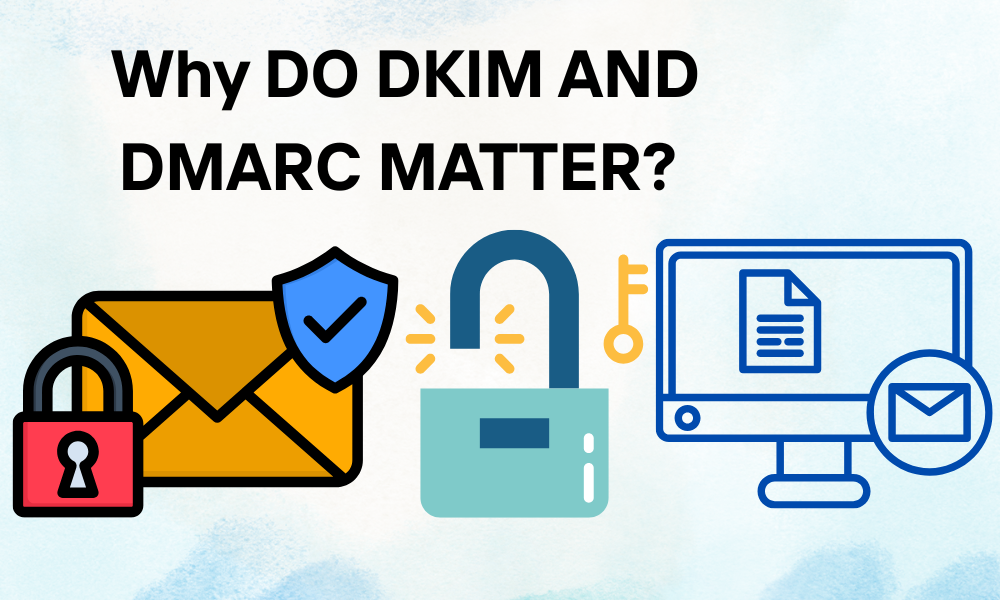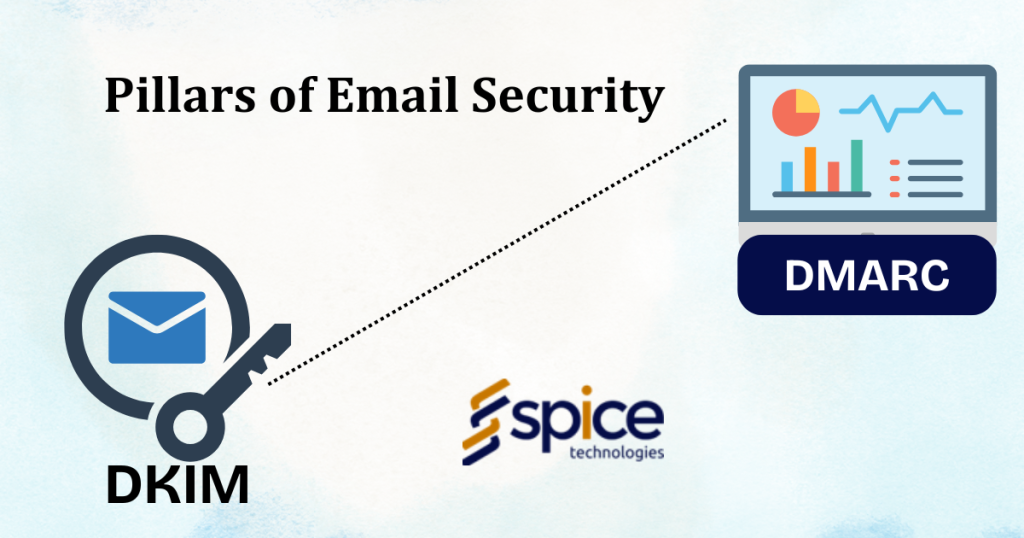In today’s digital world, email remains one of the most powerful tools for business communication — but it’s also one of the most exploited by cybercriminals. Phishing, spoofing, and spam are everyday threats that can damage a company’s reputation and compromise sensitive information. This is where DKIM and DMARC step in.
In this blog post, we’ll break down what these terms mean, how they work, and why they are essential for your business email security
What is DKIM?
DKIM stands for Domain Keys Identified Mail. It’s an email authentication method that allows the receiver to check that an email was indeed sent and authorized by the owner of that domain. What DKIM technically does is that when a message is sent, the sender’s MTA (or a third-party service) computes a hash of selected headers and the message body, then encrypts that hash with a private key and adds a DKIM-Signature: header. The public key is published in DNS for a selector. Receivers fetch the public key and verify the signature — if verification passes, the recipient knows the message wasn’t altered and that the signer controls the private key for the signing domain.
Here’s how it works in simple terms:
- When you send an email, DKIM adds a digital signature to the email header.
- This signature is encrypted and linked to your domain name.
- The recipient’s mail server uses the public key (stored in your domain’s DNS records) to verify the signature.
- If the email was altered in transit, the signature won’t match — and the email will be flagged or rejected.
Think of DKIM like a wax seal on a letter: if the seal is broken, the recipient knows it might’ve been tampered with.
What is DMARC?
DMARC stands for Domain-based Message Authentication, Reporting, and Conformance. It’s built on top of DKIM and another authentication method called SPF (Sender Policy Framework). DMARC tells receiving mail systems how to handle messages that fail authentication (fail both DKIM and SPF alignment), and instructs them whether to deliver, quarantine, or reject such mail. It also requests reporting so you can see who’s sending mail on your behalf.
DMARC helps you:
- Tell email receivers what to do if an email fails authentication (reject, quarantine, or do nothing).
- Protect your domain from spoofing and phishing attacks.
- Receive reports about who’s sending emails on your behalf — legitimate or not.
With a DMARC policy in place, domain owners gain visibility and control over their email domain’s use.

Why Do DKIM and DMARC Matter?
Email is the front door to most business communications and also the front line for cyberattacks. Every day, cybercriminals send billions of phishing and spoofed emails designed to look like they’re from trusted brands. Without proper authentication, your domain can be abused without your knowledge.
DKIM and DMARC directly address this problem by ensuring only legitimate, verified senders can use your domain name in email.
Here’s why they’re essential:
1. Protect Your Brand Reputation
If someone forges your domain in a phishing email and tricks customers or partners, it’s your brand they’ll blame. DKIM and DMARC help stop these spoofed messages before they reach inboxes, keeping your company’s name clean.
2. Improve Email Deliverability
Mailbox providers like Gmail, Outlook, and Yahoo use authentication results as part of their spam filtering.
- Messages that pass DKIM and DMARC are far more likely to land in the inbox.
- Messages that fail can be quarantined or rejected entirely.
For marketing, sales, and transactional messages, deliverability equals revenue.
3. Prevent Phishing & Spoofing Attacks
- DKIM ensures an email’s content hasn’t been altered in transit and that it really came from the claimed domain.
- DMARC enforces that the visible “From:” address matches the authenticated domain, making it much harder for attackers to impersonate you.
4. Gain Visibility Into Email Abuse
DMARC reports give you a clear view of who is sending email as your domain — both legitimate senders (your marketing platform, CRM, helpdesk, etc.) and unauthorized ones (spammers, phishers).
This visibility lets you detect abuse, uncover forgotten systems, and take action.
5. Comply with Modern Email Security Requirements
Starting in 2024, major email providers like Google and Yahoo began requiring bulk senders to have DKIM, SPF, and DMARC in place.
Without them, your emails risk being flagged or blocked, even if they’re legitimate.
6. Reduce Business Risk
Phishing is one of the top causes of:
- Account takeovers
- Fraudulent payments
- Data breaches
Blocking spoofed emails at the gateway greatly reduces these risks.
✅ Bottom line: DKIM and DMARC are not just “nice-to-have” — they’re essential infrastructure for protecting your brand, your customers, and your ability to reach the inbox.

